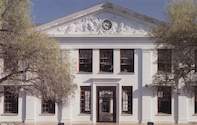Demand for Education
The need for advanced education in the Cape Colony in the early 1800s was a joint ecumenical and civic venture, funded through an issue of shares to the public.

With four other schoolmasters who had immigrated from Britain a few years earlier, the Cape could boast only a dozen teachers. Fortunately for the growing population of the new colony, in the years up to 1827 more teachers arrived; among them were three young Scotsmen who were instrumental in establishing the South African College Schools - James Rose Innes, John Fairbairn and James Adamson.
Neither Cape Town nor the colony under its administration could boast a functioning high school, let alone a university college. And so, ironically, while the Cape Colony was going through a growth experience encompassing innovations from press freedoms to the independence of the Supreme Court, from the arrival of the first steamship to the establishment of a Royal Observatory, the glaring deficiencies in educational facilities were becoming a matter of urgent concern.
In 1829, it was proclaimed that a new college would be opening in the Cape. This led to the birth of the oldest English-medium senior school in South Africa. It was truly a cooperative effort, not only between the churches of the Cape but also with the blessing and administrative support of the local Dutch community.
The Dutch Reformed Church in Cape Town offered £100 a year to cover any extra expenses and the founding committee's first joint secretaries were Advocate Johannes de Wet and Mr DW Hertzog. Although its constitution was drafted in English, the only official language in the colony, the Dutch title of Het Zuid Afrikaansch Athenaeum was adopted. The school was formally inaugurated as the South African College on 1 October 1829 in the Groote Kerk.
Modest Beginnings
The school itself had less than wholesome accommodation: for the first 12 years of its life it shared quarters with an orphanage in Long Street. The Athenaeum was given the front rooms of the building and the school activities were partitioned off from the orphanage itself. The committee of 15 laid down the rules by which the college would be administered, including the entrance qualifications which were a minimum age of 10 and 'reading, writing and a competent knowledge of the first rules of arithmetic'.
As for fees, 'each student shall annually contribute to the funds of the college a sum of five pounds sterling and likewise two pounds to each Professor whose instruction he receives and as the course will be so arranged that each pupil will generally attend only two classes, the annual expense to each pupil will be nine pounds sterling.'
The council also decided that there would be no immediate principal, but that the tutoring would be undertaken by at least four professors. In fact, the school began with 115 pupils receiving instruction from only three professors; while Reverend Abraham Faure and Reverend Adamson, members of the founding committee, both volunteered to teach for the first year without any pay, Reverend Edward Judge was appointed at a stipend of £300 a year as the English professor of Classics.
They were modest enough beginnings — and not without their problems. Within a year of the college having opened, it was near to collapse. A row broke out over religious teaching by ministers outside of the school. Several of the governors, including the president, Sir Johannes Truter, resigned. Reverend Judge left to run his own grammar school, Reverend Faure retired and even James Adamson temporarily gave up his post and returned to his native Scotland, ostensibly to look for new teachers.
It was the irrepressible John Fairbairn who stepped in to save the situation, persuading the school council to quickly fill the gaps in the teaching staff and, in a stroke of genius, inviting Professor James Rose Innes to take up the chair of mathematics. On his arrival in Cape Town, Rose Innes had been despatched to Uitenhage, where he had laboured to provide a secondary education to Boer children. When the South African College lost the mercurial James Adamson it was with some desperation that it finally appealed to Rose Innes for help.
When the college fell on financially hard times and had to drastically cut back on staff salaries, Rose Innes and Changuoin took on extra private tuition work to make ends meet. James Adamson meanwhile returned from Scotland and offered to teach again, as a fourth professor, in order that the 'total collapse' of the college could be prevented.